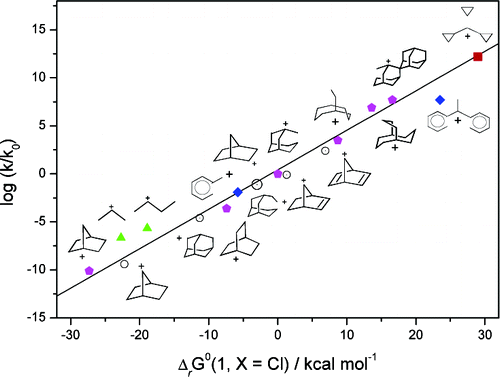Publication 167
-
J.-L.M. Abboud, I. Alkorta, J.Z. Davalos, P. Müller, E. Quintanilla, J.-C. Rossier,
“Influence of Carbocation Stability in the Gas Phase on Solvolytic Reactivity: Beyond Bridgehead Derivatives”
J. Org. Chem. 2003, 68, 3786-3796.

The intrinsic gas-phase stability of bicyclic secondary carbocations has been determined by Dissociative Proton Attachment of chlorides and alcohols, respectively. From these data, Gibbs free energies for hydride transfer relative to 1-adamantyl (ΔrG°(8,exp)) are derived after application of appropriate leaving group corrections, and good agreement with theoretical values, (ΔrG°(8,comp)), calculated at the G2(MP2) or MP2/6-311G(d,p) level, is reached (Table 1). The relative rate constants for solvolysis (log(k/k0)) of the bicyclic secondary derivatives correlate with the stabilities of the respective carbocations in the same manner as tertiary bridgehead derivatives, but simple monoderivatives and acyclic derivatives solvolyze faster than predicted on the grounds of the ion stabilities. The corresponding stabilities of cyclopropyl- and benzyl-substituted carbocations have been obtained by a combination of experimental and computational data available in the literature with computational methods. Correlation of the rate constants for solvolysis vs ion stabilities for these compounds reveals a trend similar to that observed for bridgehead derivatives, but with much more scatter, which is attributed to nucleophilic solvent participation and/or nucleophilic solvation.
DOI : 10.1021/jo026539s
